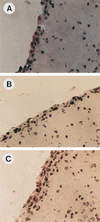The capsule supports survival but not traversal of Escherichia coli K1 across the blood-brain barrier
- PMID: 10377140
- PMCID: PMC116545
- DOI: 10.1128/IAI.67.7.3566-3570.1999
The capsule supports survival but not traversal of Escherichia coli K1 across the blood-brain barrier
Abstract
The vast majority of cases of gram-negative meningitis in neonates are caused by K1-encapsulated Escherichia coli. The role of the K1 capsule in the pathogenesis of E. coli meningitis was examined with an in vivo model of experimental hematogenous E. coli K1 meningitis and an in vitro model of the blood-brain barrier. Bacteremia was induced in neonatal rats with the E. coli K1 strain C5 (O18:K1) or its K1(-) derivative, C5ME. Subsequently, blood and cerebrospinal fluid (CSF) were obtained for culture. Viable bacteria were recovered from the CSF of animals infected with E. coli K1 strains only; none of the animals infected with K1(-) strains had positive CSF cultures. However, despite the fact that their cultures were sterile, the presence of O18 E. coli was demonstrated immunocytochemically in the brains of animals infected with K1(-) strains and was seen by staining of CSF samples. In vitro, brain microvascular endothelial cells (BMEC) were incubated with K1(+) and K1(-) E. coli strains. The recovery of viable intracellular organisms of the K1(+) strain was significantly higher than that for the K1(-) strain (P = 0.0005). The recovery of viable intracellular K1(-) E. coli bacteria was increased by cycloheximide treatment of BMEC (P = 0.0059) but was not affected by nitric oxide synthase inhibitors or oxygen radical scavengers. We conclude that the K1 capsule is not necessary for the invasion of bacteria into brain endothelial cells but is responsible for helping to maintain bacterial viability during invasion of the blood-brain barrier.
Figures




Similar articles
-
Role of OmpA and IbeB in Escherichia coli K1 invasion of brain microvascular endothelial cells in vitro and in vivo.Pediatr Res. 2002 May;51(5):559-63. doi: 10.1203/00006450-200205000-00003. Pediatr Res. 2002. PMID: 11978877
-
The gene locus yijP contributes to Escherichia coli K1 invasion of brain microvascular endothelial cells.Infect Immun. 1999 Sep;67(9):4751-6. doi: 10.1128/IAI.67.9.4751-4756.1999. Infect Immun. 1999. PMID: 10456927 Free PMC article.
-
Effect of rpoS mutations on stress-resistance and invasion of brain microvascular endothelial cells in Escherichia coli K1.FEMS Microbiol Lett. 2000 Jan 15;182(2):241-7. doi: 10.1111/j.1574-6968.2000.tb08902.x. FEMS Microbiol Lett. 2000. PMID: 10620673
-
Strategy of Escherichia coli for crossing the blood-brain barrier.J Infect Dis. 2002 Dec 1;186 Suppl 2:S220-4. doi: 10.1086/344284. J Infect Dis. 2002. PMID: 12424701 Review.
-
Current concepts on Escherichia coli K1 translocation of the blood-brain barrier.FEMS Immunol Med Microbiol. 2004 Nov 1;42(3):271-9. doi: 10.1016/j.femsim.2004.09.001. FEMS Immunol Med Microbiol. 2004. PMID: 15477040 Review.
Cited by
-
IbeR facilitates stress-resistance, invasion and pathogenicity of avian pathogenic Escherichia coli.PLoS One. 2015 Mar 13;10(3):e0119698. doi: 10.1371/journal.pone.0119698. eCollection 2015. PLoS One. 2015. PMID: 25768126 Free PMC article.
-
Application of signature-tagged mutagenesis for identification of escherichia coli K1 genes that contribute to invasion of human brain microvascular endothelial cells.Infect Immun. 2000 Sep;68(9):5056-61. doi: 10.1128/IAI.68.9.5056-5061.2000. Infect Immun. 2000. PMID: 10948125 Free PMC article.
-
Citrobacter koseri brain abscess in the neonatal rat: survival and replication within human and rat macrophages.Infect Immun. 2003 Oct;71(10):5871-80. doi: 10.1128/IAI.71.10.5871-5880.2003. Infect Immun. 2003. PMID: 14500508 Free PMC article.
-
Two functional type VI secretion systems in avian pathogenic Escherichia coli are involved in different pathogenic pathways.Infect Immun. 2014 Sep;82(9):3867-79. doi: 10.1128/IAI.01769-14. Epub 2014 Jun 30. Infect Immun. 2014. PMID: 24980972 Free PMC article.
-
A convergent evolutionary pathway attenuating cellulose production drives enhanced virulence of some bacteria.Nat Commun. 2024 Feb 21;15(1):1441. doi: 10.1038/s41467-024-45176-4. Nat Commun. 2024. PMID: 38383596 Free PMC article.
References
-
- Babior B M. Oxygen-dependent microbial killing by phagocytes. N Engl J Med. 1978;298:659–668. - PubMed
-
- Carter W O, Narayanan P K, Robinson J P. Intracellular hydrogen peroxide and superoxide anion detection in endothelial cells. J Leukoc Biol. 1994;55:253–258. - PubMed
-
- Catalan R E, Martinez A M, Aragones M D, Hernandez F. Identification of nitric oxide synthases in isolated bovine brain vessels. Neurosci Res. 1996;25:195–199. - PubMed
Publication types
MeSH terms
Grants and funding
LinkOut - more resources
Full Text Sources
Medical
Miscellaneous

